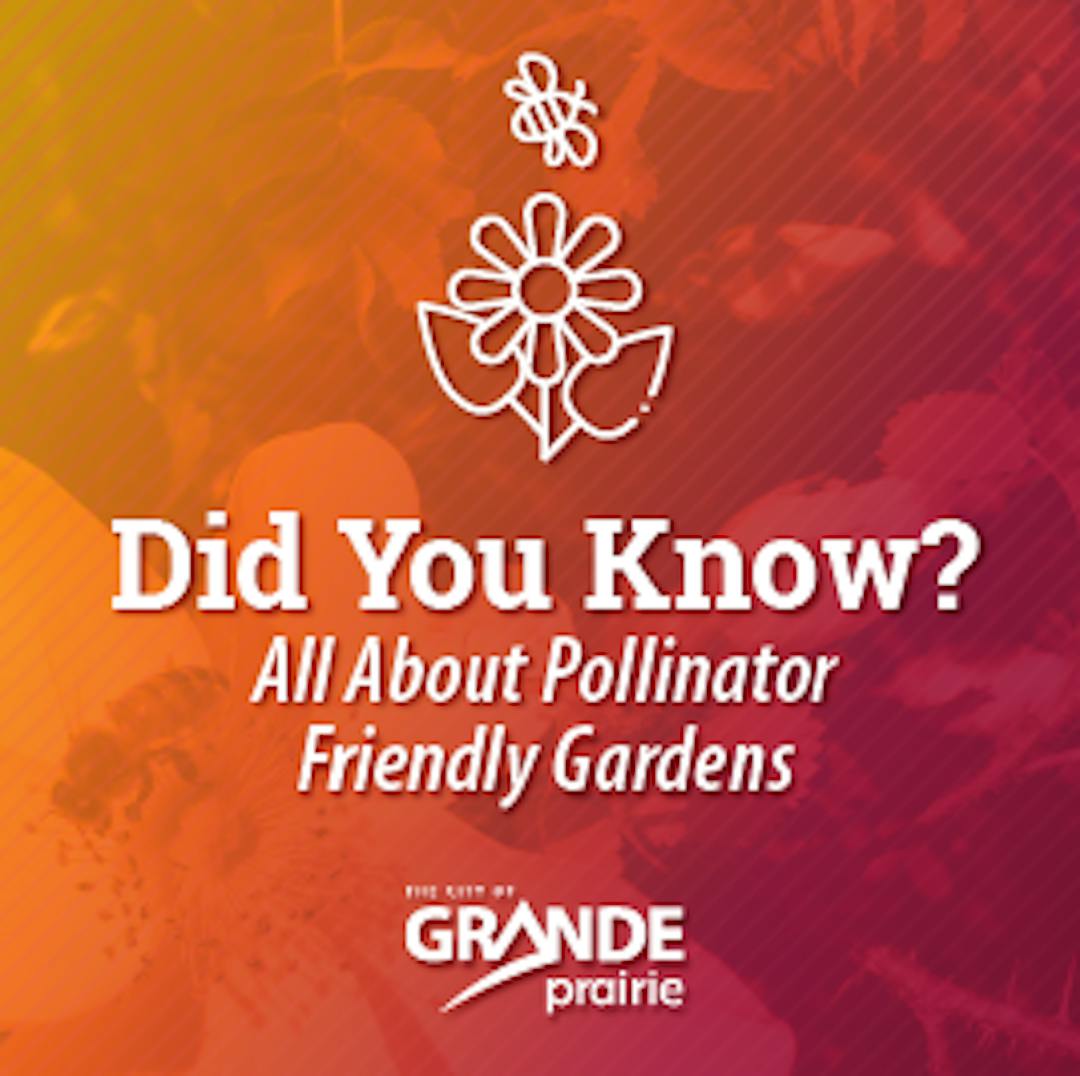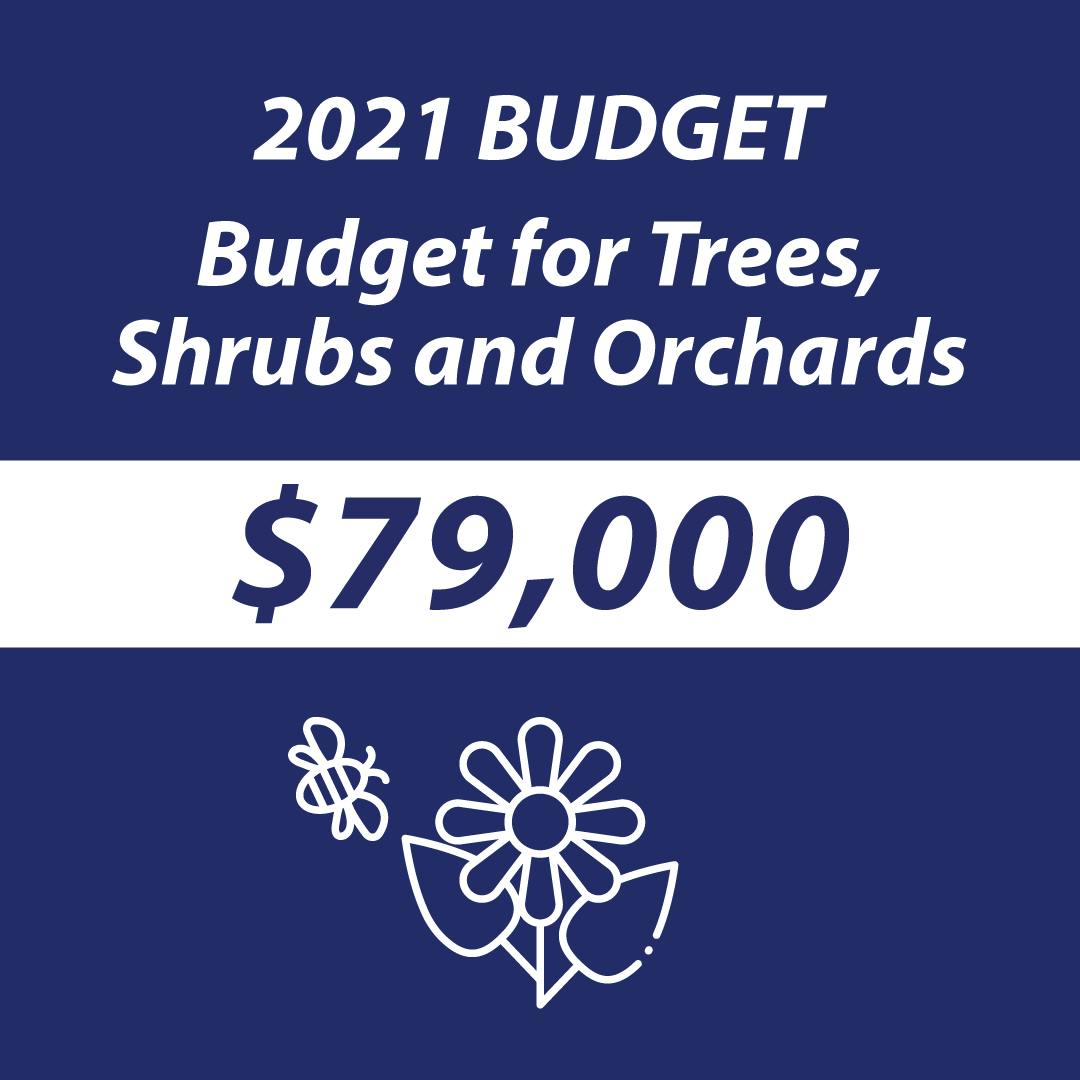Pollinators in Grande Prairie bring along great benefits. They pollinate our crops, garden beds and are responsible for over 90% of the world's produce. Keeping them safe and healthy is everyone's job. This is why the City of Grande Prairie has implemented Edible Landscaping and Community Garden policies and procedures to help them thrive.
More About Pollinators
Most people are unaware that bees are not the only pollinators. Butterflies, birds, moths, wasps and other insects are all considered pollinators and are important for supporting local food production and contributing to plant health through cross-pollination.
Around the world, pollinators are struggling to survive amidst growing threats to their homes and health. In Canada, we have seen significant reductions in some pollinator species, including bees and butterflies, such as the beautiful monarch butterfly. Around 90% of plant species need pollination to aid in reproduction. Most of those plants are fruit or vegetable bearing.
Grande Prairie's Commitment as a Bee City
The City of Grande Prairie is proud to be an official Bee City, as of October 19, 2020. What does this mean? Being a Bee City recognizes our commitment to supporting pollinator protection. Some initiatives that we are doing to protect and support local pollinator populations includes:
- Ground cover in our community orchards planted to provide pollen when sources are in short supply
- Committed to an Edible Landscaping Policy 212 across the City to plant a specific portion of trees each year that produce edible crops. These trees produce flowers that feed pollinators

- Significantly reduced the use of insecticides since 2015
Planting orchards and trees in the City provides a natural habitat for all life that lives in Grande Prairie. It provides shelters, homes and food for animals. It also helps keep us cool in the summer and reduces noise pollution. Trees also play a key role in keeping erosion at bay and storing carbon.
Edible Landscaping
Edible Landscaping provides sustainable and accessible community food that is available for everyone. There are currently 11 community orchards planted throughout the City for residents to pick and enjoy the sweet flavours of fresh, organic fruits.
In 2014, the Edible Landscaping Policy came into place which sees the City plant a specific portion of trees each year that produce edible crops on municipal landscapes. Since then, Parks Operations has planted hundreds of shrubs and edible trees. These orchards grow on their own and are hardy to our region. Check out the list of edible food that can be found throughout the City's orchards:
- Apples
- Haskaps
- Saskatoons
- Raspberries
- Plums
- Rhubarb
- Goji Berries
- Grapes
- Pears
- Currants
Check out the community orchard maps to find your next picking spot and please remember these tips when going out to pick:
- When you are bringing your produce home make sure to give it a good wash to remove any bacteria
- Some berries grow on bushes that have sharp thorns so bring gloves
Community Gardens
 In 2020 the City of Grande Prairie implemented the first learning garden at the Coca-Cola Centre to teach participants of the GP Grows Gardening program how to grow and care for their gardens. Through this project, we were able to donate 6 full garbage bags of Swiss chard (3 harvests), approximately 10-15 lbs of radishes, 327 beets, and 350 carrots to the Grande Prairie Friendship Centre Community Kitchen.
In 2020 the City of Grande Prairie implemented the first learning garden at the Coca-Cola Centre to teach participants of the GP Grows Gardening program how to grow and care for their gardens. Through this project, we were able to donate 6 full garbage bags of Swiss chard (3 harvests), approximately 10-15 lbs of radishes, 327 beets, and 350 carrots to the Grande Prairie Friendship Centre Community Kitchen.
The Reverend Forbes Homestead just implemented a community garden this past spring, located where a historic vegetable garden used to be. The garden is open for viewing to the public and includes plants and vegetables that once grew on the homestead in the mid 1900s. These include peas, carrots, tomatoes, corn, radishes, beets and raspberry bushes. Four loads of fresh vegetables have been taken to the local community kitchens. The site is open by appointment until the end of September.
At the Ernie Radbourne Pavilion along the side that faces the pond, annual flowers have been replaced with strawberry plants. Each year they will produce strawberries that you can harvest while enjoying the park.
Pollinators in Grande Prairie bring along great benefits. They pollinate our crops, garden beds and are responsible for over 90% of the world's produce. Keeping them safe and healthy is everyone's job. This is why the City of Grande Prairie has implemented Edible Landscaping and Community Garden policies and procedures to help them thrive.
More About Pollinators
Most people are unaware that bees are not the only pollinators. Butterflies, birds, moths, wasps and other insects are all considered pollinators and are important for supporting local food production and contributing to plant health through cross-pollination.
Around the world, pollinators are struggling to survive amidst growing threats to their homes and health. In Canada, we have seen significant reductions in some pollinator species, including bees and butterflies, such as the beautiful monarch butterfly. Around 90% of plant species need pollination to aid in reproduction. Most of those plants are fruit or vegetable bearing.
Grande Prairie's Commitment as a Bee City
The City of Grande Prairie is proud to be an official Bee City, as of October 19, 2020. What does this mean? Being a Bee City recognizes our commitment to supporting pollinator protection. Some initiatives that we are doing to protect and support local pollinator populations includes:
- Ground cover in our community orchards planted to provide pollen when sources are in short supply
- Committed to an Edible Landscaping Policy 212 across the City to plant a specific portion of trees each year that produce edible crops. These trees produce flowers that feed pollinators

- Significantly reduced the use of insecticides since 2015
Planting orchards and trees in the City provides a natural habitat for all life that lives in Grande Prairie. It provides shelters, homes and food for animals. It also helps keep us cool in the summer and reduces noise pollution. Trees also play a key role in keeping erosion at bay and storing carbon.
Edible Landscaping
Edible Landscaping provides sustainable and accessible community food that is available for everyone. There are currently 11 community orchards planted throughout the City for residents to pick and enjoy the sweet flavours of fresh, organic fruits.
In 2014, the Edible Landscaping Policy came into place which sees the City plant a specific portion of trees each year that produce edible crops on municipal landscapes. Since then, Parks Operations has planted hundreds of shrubs and edible trees. These orchards grow on their own and are hardy to our region. Check out the list of edible food that can be found throughout the City's orchards:
- Apples
- Haskaps
- Saskatoons
- Raspberries
- Plums
- Rhubarb
- Goji Berries
- Grapes
- Pears
- Currants
Check out the community orchard maps to find your next picking spot and please remember these tips when going out to pick:
- When you are bringing your produce home make sure to give it a good wash to remove any bacteria
- Some berries grow on bushes that have sharp thorns so bring gloves
Community Gardens
 In 2020 the City of Grande Prairie implemented the first learning garden at the Coca-Cola Centre to teach participants of the GP Grows Gardening program how to grow and care for their gardens. Through this project, we were able to donate 6 full garbage bags of Swiss chard (3 harvests), approximately 10-15 lbs of radishes, 327 beets, and 350 carrots to the Grande Prairie Friendship Centre Community Kitchen.
In 2020 the City of Grande Prairie implemented the first learning garden at the Coca-Cola Centre to teach participants of the GP Grows Gardening program how to grow and care for their gardens. Through this project, we were able to donate 6 full garbage bags of Swiss chard (3 harvests), approximately 10-15 lbs of radishes, 327 beets, and 350 carrots to the Grande Prairie Friendship Centre Community Kitchen.
The Reverend Forbes Homestead just implemented a community garden this past spring, located where a historic vegetable garden used to be. The garden is open for viewing to the public and includes plants and vegetables that once grew on the homestead in the mid 1900s. These include peas, carrots, tomatoes, corn, radishes, beets and raspberry bushes. Four loads of fresh vegetables have been taken to the local community kitchens. The site is open by appointment until the end of September.
At the Ernie Radbourne Pavilion along the side that faces the pond, annual flowers have been replaced with strawberry plants. Each year they will produce strawberries that you can harvest while enjoying the park.

 In 2020 the City of Grande Prairie implemented the first learning garden at the Coca-Cola Centre to teach participants of the GP Grows Gardening program how to grow and care for their gardens. Through this project, we were able to donate 6 full garbage bags of Swiss chard (3 harvests), approximately 10-15 lbs of radishes, 327 beets, and 350 carrots to the Grande Prairie Friendship Centre Community Kitchen.
In 2020 the City of Grande Prairie implemented the first learning garden at the Coca-Cola Centre to teach participants of the GP Grows Gardening program how to grow and care for their gardens. Through this project, we were able to donate 6 full garbage bags of Swiss chard (3 harvests), approximately 10-15 lbs of radishes, 327 beets, and 350 carrots to the Grande Prairie Friendship Centre Community Kitchen. 


